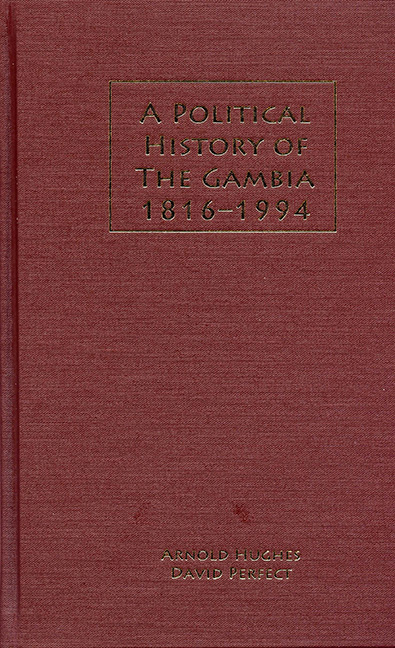Book contents
- Frontmatter
- Dedication
- Map
- Contents
- List of Tables
- List of Interviewees
- Acknowledgments
- Abbreviations
- Introduction
- 1 Social and Economic Setting
- 2 Constitutional Change in The Gambia, 1816–1994
- 3 Merchants and Recaptives: The Origins of Modern Politics, 1816–86
- 4 Patrician Politics in the Era of the Forsters, 1886–1941
- 5 The Establishment of Party Politics, 1941–59
- 6 The “Green Uprising”: The Emergence of the People's Progressive Party, 1959–65
- 7 Electoral Politics, 1965–81
- 8 Radical and Insurrectionary Political Challenges, 1965–81
- 9 Electoral Politics, 1981–94
- 10 The Gambia's External Relations, 1965–94
- 11 The 1994 Coup and the Jawara Legacy
- Appendix A Major Constitutional Changes, 1816–1994
- Appendix B Legislative Council Election Results, 1947–54
- Appendix C General Election and By-Election Results, 1960–93
- Appendix D Presidential Election Results, 1982–92
- Appendix E Republic Referendum Results, 1970
- Appendix F Primary Sources
- Appendix G Newspapers and Magazines Consulted
- Notes
- Bibliography
- Index
- Rochester Studies in African History and the Diasora
9 - Electoral Politics, 1981–94
Published online by Cambridge University Press: 13 April 2017
- Frontmatter
- Dedication
- Map
- Contents
- List of Tables
- List of Interviewees
- Acknowledgments
- Abbreviations
- Introduction
- 1 Social and Economic Setting
- 2 Constitutional Change in The Gambia, 1816–1994
- 3 Merchants and Recaptives: The Origins of Modern Politics, 1816–86
- 4 Patrician Politics in the Era of the Forsters, 1886–1941
- 5 The Establishment of Party Politics, 1941–59
- 6 The “Green Uprising”: The Emergence of the People's Progressive Party, 1959–65
- 7 Electoral Politics, 1965–81
- 8 Radical and Insurrectionary Political Challenges, 1965–81
- 9 Electoral Politics, 1981–94
- 10 The Gambia's External Relations, 1965–94
- 11 The 1994 Coup and the Jawara Legacy
- Appendix A Major Constitutional Changes, 1816–1994
- Appendix B Legislative Council Election Results, 1947–54
- Appendix C General Election and By-Election Results, 1960–93
- Appendix D Presidential Election Results, 1982–92
- Appendix E Republic Referendum Results, 1970
- Appendix F Primary Sources
- Appendix G Newspapers and Magazines Consulted
- Notes
- Bibliography
- Index
- Rochester Studies in African History and the Diasora
Summary
Even though the State of Emergency, which was introduced immediately after the end of the attempted coup of July–August 1981, had not yet been lifted, the government decided to honor the constitutional requirement to conduct five yearly elections in May 1982. Further rounds of elections took place in 1987 and 1992. On all three occasions, the People's Progressive Party (PPP) reaffirmed its dominance over the legislature, resorting to familiar techniques of patronage and the mobilization of state resources to ensure success at the polls against the National Convention Party (NCP) and a variety of other opponents. However, the PPP was much less successful in dealing with more deep-seated political problems. There was accumulating evidence over the next decade of a renewed complacency and an unwillingness or incapacity to undertake the kind of fundamental political and administrative changes needed to dissuade future extra-constitutional adventures of the kind launched by Kukoi Samba Sanyang. In the end, this proved fatal; three years before the next scheduled election in 1997, the PPP government was overthrown in a second, and this time successful, coup in July 1994.
1982 Parliamentary and Presidential Elections
The government's decision to proceed with the elections despite the coup showed that it was determined to reestablish The Gambia's reputation as a parliamentary democracy both at home and abroad. It also enabled the PPP to measure its support among the electorate soon after the traumatic events of the previous summer. Furthermore, in the absence of a separate referendum, the elections demonstrated the extent of public support for the decision to establish a confederation with Senegal, which went into effect in February 1982 (see Chapter 10).
One important constitutional innovation in 1982 (which was endorsed by both the NCP and the PPP) was that conjointly elections were held for the office of president as well as for the House of Representatives. Each elector voted twice at the same polling station, but at different booths. The number of “nominated” members of parliament (MPs) was also increased from five to eight to widen the president's scope when making appointments to the cabinet. Three parties fought the election: the PPP, which held thirty-two seats at the dissolution, the NCP, which held the remaining three seats, and the United Party (UP), which had been unrepresented in Parliament since 1978.
- Type
- Chapter
- Information
- A Political History of the Gambia, 1816–1994 , pp. 221 - 250Publisher: Boydell & BrewerPrint publication year: 2006

